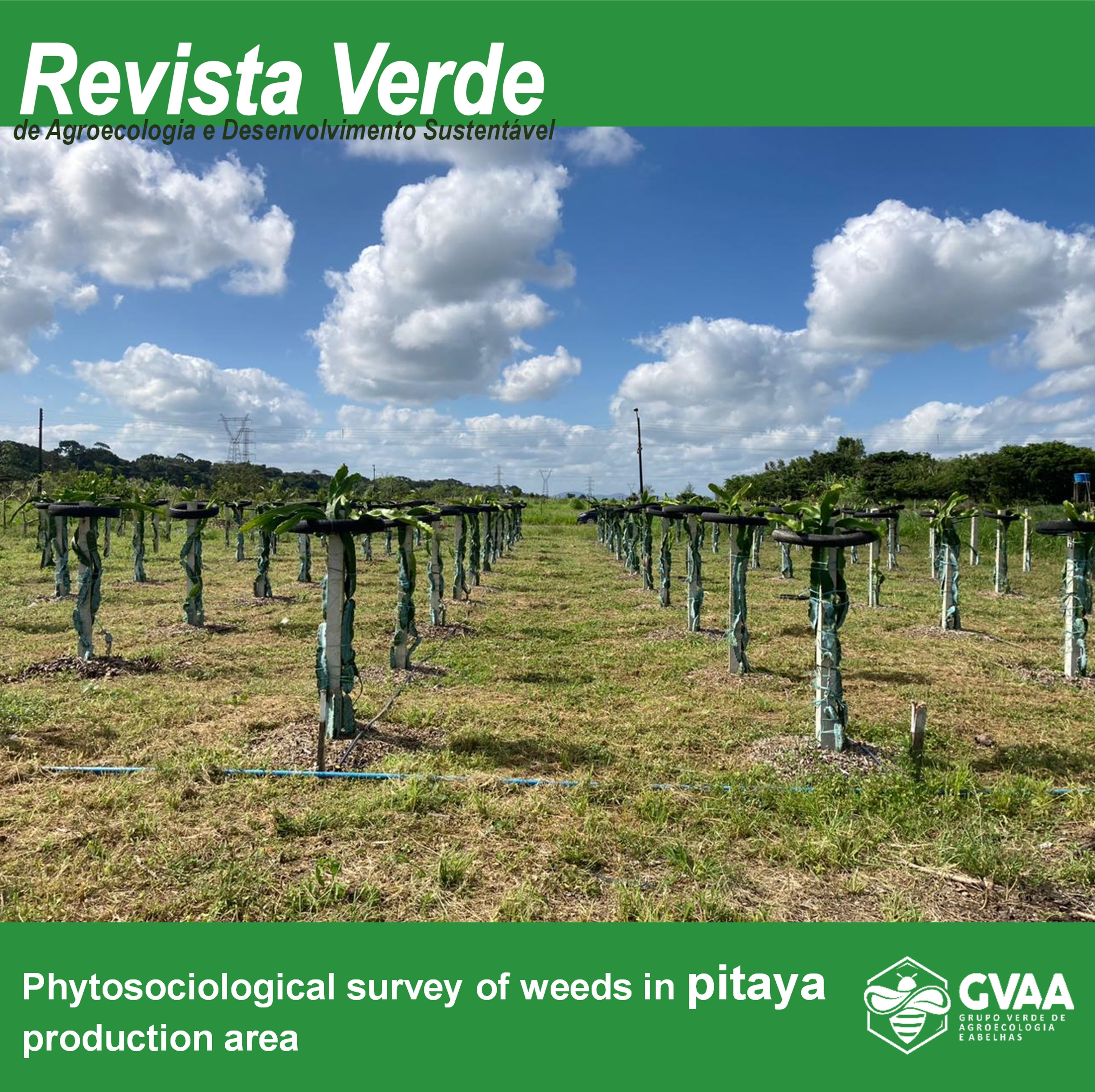Phytosociological survey of weeds in pitaya production area
DOI:
https://doi.org/10.18378/rvads.v18i4.9802Keywords:
Phytosociology, Hylocereus sp., CactusAbstract
The pitaya has gained prominence in the exotic fruit market in Brazil, however, several factors limit productivity, among them, the interference caused by weeds. In this context, the identification of weed population dynamics is the first step towards the adoption of integrated management, contributing to efficient and sustainable control, and can be carried out through a phytosociological survey. The objective of this work was to identify and quantify the floristic composition of weeds in a pitaya orchard, in the first year of implementation, in the municipality of Rio Largo, Alagoas, Brazil. Phytosociology was carried out 120 days after planting, using a hollow square 0.50 m wide, the species were collected, identified, counted and placed in an oven at 65 °C. The following indices were calculated: density, relative density, frequency, relative frequency, importance value index, abundance, relative abundance, dry mass, relative dry mass and relative importance index. The community of weeds showed considerable diversity, with 24 species distributed in 12 botanical families, with Poaceae and Asteraceae having the highest occurrences. It was observed that the species Cenchrus echinatus, Ageratum conyzoides, Galinsoga parviflora, Eleusine indica and Eclipta alba had the highest abundance class, index of relative importance value, and should be the main species for control.
Downloads
References
ALVARES, C. A.; Köppen's climate classification map for Brazil. Meteorologische Zeitschrift, 22 (1), p 711, 2014. DOI: https://doi.org/10.1127/0941-2948/2013/0507
BRAUN-BLANQUET, J. Fitossociologia: bases para el estudio de las comunidades vegetales. Madrid: H. Blume, 1979. 820 p.
CURTIS, J. T.; MCINTOSH, R. P. The interrelations of certain analytic and synthetic phytossociological characters. Ecology, 31, (3), p. 434-455, 1950. https://doi.org/10.2307/1931497 DOI: https://doi.org/10.2307/1931497
CRUZ, M. C M.; MARTINS, R. S. Pitaia no Brasil, nova opção de cultivo. 1ed. Santa Catarina: Epagri, 2022, 351 p.
FLECK, N. G.; LAZAROTO, C. A.; SCHAEDLER, C. E.; FERREIRA, F. B. Controle de papuã (Brachiaria plantaginea) em soja em função da dose e da época de aplicação da herbicida clethodim. Planta Daninha, 26, (2), p. 375-383, 2008. https://doi.org/10.1590/S0100-83582008000200014 DOI: https://doi.org/10.1590/S0100-83582008000200014
FREITAS, F. C. L.; ALMEIDA, M. E. L.; NEGREIROS, M. Z.; HONORATO, A. R. F.; MESQUITA, H. C.; SILVA, S. V. O. F. Períodos de interferência de plantas daninhas na cultura da cenoura em função do espaçamento entre fileiras, Planta daninha, 27, (3), p. 473-480, 2009. https://doi.org/10.1590/S0100-83582009000300007 DOI: https://doi.org/10.1590/S0100-83582009000300007
GODOY, G.; VEGA, J.; PITTY, A. El tipo de labranza afecta la flora y la distribución vertical del banco de semillas de malezas. Ceiba, 36, (2), p. 217-229, 1995.
IBGE, Instituto Brasileiro de Geografia e Estatística. Produção Agrícola Municipal de 2017. Disponível em: <https://cidades.ibge.gov.br/brasil/pesquisa/24/76693>. Acessado em: 22 de dezembro de 2022.
LORENZI, H. Manual de identificação e controle de plantas daninhas, plantio direto e convencional. 7ed. São Paulo: IPEF, 2014, 384 p.
MUELLER-DOMBOIS, D.; ELLENBERG, H. Aims and methods of vegetation ecology. New York: John Wiley, 1974. 547 p.
NASCIMENTO, P. G. M. L.; SILVA, M. G. O.; FONTES, L. O.; RODRIGUES, A. P. M. S.; MESQUITA, H. C.; FREITAS, F. C. L. Levantamento fitossociológico das comunidades infestantes em diferentes sistemas de plantio de milho. Agropecuária Científica no SemiÁrido, 7, (3), p. 1-9, 2011.
OLIVEIRA, A. R.; FREITAS, S. P. Levantamento fitossociológico de plantas daninhas em áreas de produção de cana-de-açúcar. Planta Daninha, 26, (1), 33-46, 2008. https://doi.org/10.1590/S0100-83582008000100004 DOI: https://doi.org/10.1590/S0100-83582008000100004
SANTOS, D. N.; PIO, L. A. S.; FALEIRO, F. G. Pitaya uma alternativa frutífera. 1ed. Brasília: EMBRAPA, 2022, 68 p.
SANTOS, M. M.; GALVÃO, J. C. C; MIRANDA, G. V.; FERREIRA, L. R.; MELO, A. V.; FONTANETTI, A. Espaçamento entre fileiras e adubação nitrogenada na cultura do milho. Acta Scientiarum Agronomy, 29, (4), p. 527-533, 2004. https://doi.org/10.4025/actasciagron.v29i4.415 DOI: https://doi.org/10.4025/actasciagron.v29i4.415
SILVA, E. E.; ALBUQUERQUE, E. E. B.; ROCHA, T. C. S.; SANTOS, M.; SILVA, C. B.; SILVA, R. C. C.; SILVA, K. B.; COSTA, J. G. Estudo fitossociológico da comunidade infestante no pomar de pinha (Annona squamosa L.) no Município de Rio Largo – Alagoas, 5, (1), p. 1-8, 2020.
SOARES, D. J.; GRAVENA, R.; PITELLI, R. A. Efeito de diferentes períodos de controle das plantas daninhas na produtividade da cultura da cebola. Planta Daninha, v. 22, n. 4, p. 517-527, 2004. https://doi.org/10.1590/S0100-83582004000400005 DOI: https://doi.org/10.1590/S0100-83582004000400005
WATANABE, H. S.; OLIVEIRA, S. L. Comercialização de frutas exóticas. Revista Brasileira de Fruticultura, 36, (1), p. 23-38, 2014. https://doi.org/10.1590/0100-2945-443/13 DOI: https://doi.org/10.1590/0100-2945-443/13

Published
How to Cite
Issue
Section
License
Copyright (c) 2023 Romário Guimarães Verçosa de Araújo et al.

This work is licensed under a Creative Commons Attribution 4.0 International License.














